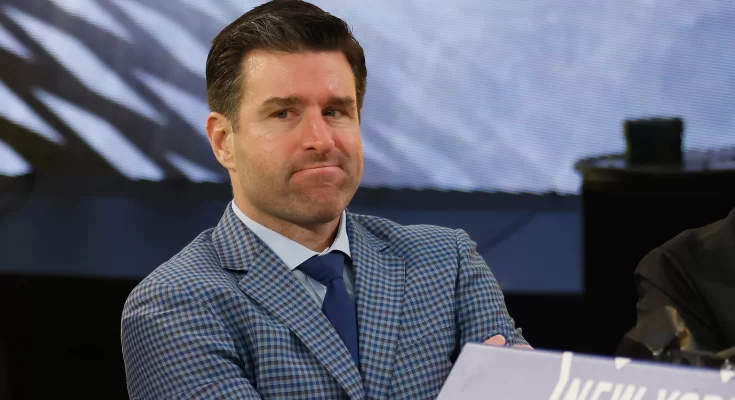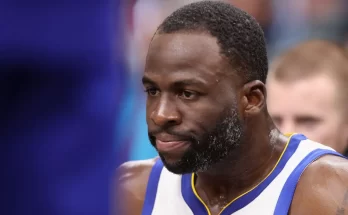When Edmonton Oilers captain Connor McDavid recently made comments that stirred speculation about his future, few could have predicted the immediate ripple effect reaching all the way to Madison Square Garden. Though McDavid did not explicitly mention the New York Rangers, his remarks have sparked intense buzz around the franchise, placing general manager Chris Drury under growing pressure to make aggressive moves before the trade deadline and shape the team’s trajectory for years to come. McDavid’s words, reflecting frustration with Edmonton’s current roster and the organization’s ability to build around him, have prompted many NHL observers and fans to wonder if a blockbuster trade could be brewing—and whether the Rangers could be involved.
The context is critical. McDavid is entering the final year of his current contract, and although he remains committed to the Oilers for now, the subtle discontent in his comments about team depth and defensive shortcomings resonate powerfully with the challenges the Rangers themselves face. New York boasts a talented core but is hampered by salary cap restrictions, a need to fill critical defensive roles, and questions about secondary scoring. The timing of McDavid’s remarks could not be more provocative, as it comes on the heels of a flurry of roster moves by Chris Drury—moves that demonstrate a clear intention to keep the Rangers competitive but also flexible.
Drury’s maneuvering throughout the offseason reveals a careful balancing act. Trading away veteran pieces like Chris Kreider has freed up around $15 million in cap space, providing some breathing room, but the team must still re-sign promising restricted free agents like K’Andre Miller and Will Cuylle, complicating cap management. Meanwhile, the Rangers swapped out their first-round pick in the 2025 draft to Pittsburgh but preserved a valuable 2026 first-rounder, a move that hints at a desire to maintain future assets for potential blockbuster trades or contract flexibility. These moves underline Drury’s strategy: improve the roster now without mortgaging the future, keeping options open for both steady growth and opportunistic acquisitions.
Drury’s approach to roster management emphasizes prudence but is not without aggression. He has shown willingness to make bold trades, such as the deadline deadline moves in March 2025, which saw players like Ryan Lindgren and Jimmy Vesey depart for draft picks and depth players like Carson Soucy. This reflected a long-term vision focused on sustainability rather than quick fixes, but it has also created some internal friction. Public reports and fan chatter suggest that some players feel uneasy with the degree of turnover and the communication style surrounding trades, particularly regarding key pieces like J.T. Miller and Kreider. These sentiments suggest that while the roster might be improving on paper, the locker room culture is a delicate variable that Drury must manage carefully to avoid fracturing team chemistry.
Against this backdrop, the McDavid factor has thrust itself onto the Rangers’ radar. For a team in pursuit of a true franchise-altering superstar, McDavid is the prize. But acquiring him would come at a significant cost. Given the Rangers’ cap constraints, pursuing McDavid would require shedding multiple valuable assets, including young talent and high draft picks. Moreover, absorbing McDavid’s contract or negotiating a long-term extension would severely limit financial flexibility. It would also place immense pressure on the coaching staff and the roster to quickly integrate a megastar’s playing style and personality.
Culturally, questions abound. McDavid’s addition would undoubtedly electrify the fan base and market, but it could also disrupt the careful balance of personalities on the team. Drury’s recent history of pushing players out and public negotiations, while intended to maximize value, have also opened some wounds. Adding a player of McDavid’s stature requires a unified locker room and strong leadership—two areas where the Rangers appear to still be evolving. The risks, therefore, are both financial and interpersonal.
Despite the temptation, the most prudent course for Drury might be to resist the allure of a splashy but potentially destabilizing acquisition. Instead, focusing on re-signing core RFAs like Miller and Cuylle at reasonable terms, while targeting role players who can contribute immediately, could better position the Rangers for sustained success. Trading pieces like Miller or Lafrenière might open doors to players who fit specific needs—such as a steady right winger or a puck-moving defenseman—but such moves should be guided by analytics and team chemistry considerations, rather than the pressure of chasing headlines.
Publicly, Drury has maintained a posture of transparency and confidence, defending recent trades and emphasizing a long-term vision for the franchise. This approach aims to quiet external speculation and stabilize fan expectations, but internal communication remains key. If rumors about locker room tensions hold weight, Drury must redouble efforts to build trust and foster a culture that embraces change without fracturing. The challenge of managing expectations on and off the ice is significant, especially when speculation about a generational talent like McDavid looms.
McDavid’s comments have undeniably shifted the landscape of offseason discussions across the NHL. For the Rangers, they represent both an opportunity and a warning. If the Oilers follow through on a trade request, a bidding war could erupt, forcing teams to reveal their cards prematurely and risk overpaying. For Drury, the key question is how aggressively to respond. Should the Rangers enter a fray that might overextend their resources, or should they stick to their blueprint and build depth incrementally?
The cap situation is perhaps the clearest limitation. Even after Kreider’s departure and the shuffling of other contracts, Drury faces the reality that signing McDavid would likely require multiple expensive players to be moved out. That not only reduces depth but also risks losing key pieces of the team’s identity and future. It’s a classic dilemma between chasing a star’s immediate impact and safeguarding long-term competitiveness.
In practical terms, Drury’s most urgent task is resolving the status of his restricted free agents. Miller, in particular, has drawn significant attention and speculation. His potential trade value is high, but so is his upside as a core part of the team’s defensive future. Similarly, Cuylle’s emergence as a young forward with scoring ability makes his contract negotiations equally important. Getting these deals done on reasonable terms will set the stage for either a full-throttle push toward contention or a patient build toward playoff depth.
Meanwhile, the Rangers’ secondary scoring and defensive depth remain issues that cannot be ignored. Adding complementary players who can ease the burden on the top lines and stabilize the blue line corps is essential. Drury has shown he is not afraid to make targeted moves, such as acquiring veterans on reasonable contracts or drafting high-potential prospects, but balancing all these needs within cap limits requires surgical precision.
Ultimately, McDavid’s recent comments have shined a bright light on the Rangers’ offseason and raised the stakes for Chris Drury. The GM finds himself at a crossroads, weighing the risks of aggressive pursuit against the benefits of measured, strategic growth. While the siren song of a superstar like McDavid is powerful, history has shown that teams that lose sight of cap discipline and locker room culture in pursuit of a single player often pay dearly.
Drury’s track record suggests he understands these nuances. His willingness to make tough trades, his attention to draft assets, and his efforts to preserve salary cap space all indicate a long-term vision. Yet the pressure is mounting. Fans, media, and even some within the organization want to see bold moves—something that signals the Rangers are serious contenders capable of competing for the Stanley Cup now.
As the trade deadline approaches and McDavid’s comments continue to fuel speculation, the onus is on Drury to navigate these competing demands with clarity and resolve. His next moves—whether locking up key RFAs, making savvy trades, or simply standing firm amid the noise—will define the Rangers’ direction for the coming years.
For now, the buzz around McDavid and the Rangers remains just that: speculation. But in the high-stakes world of NHL front offices, speculation can quickly become reality. Whether Chris Drury chooses to chase the superstar dream or stay the course with a measured approach, one thing is clear—the next chapter of the Rangers’ story is being written now, and it will require skill, patience, and perhaps a little boldness to succeed.



